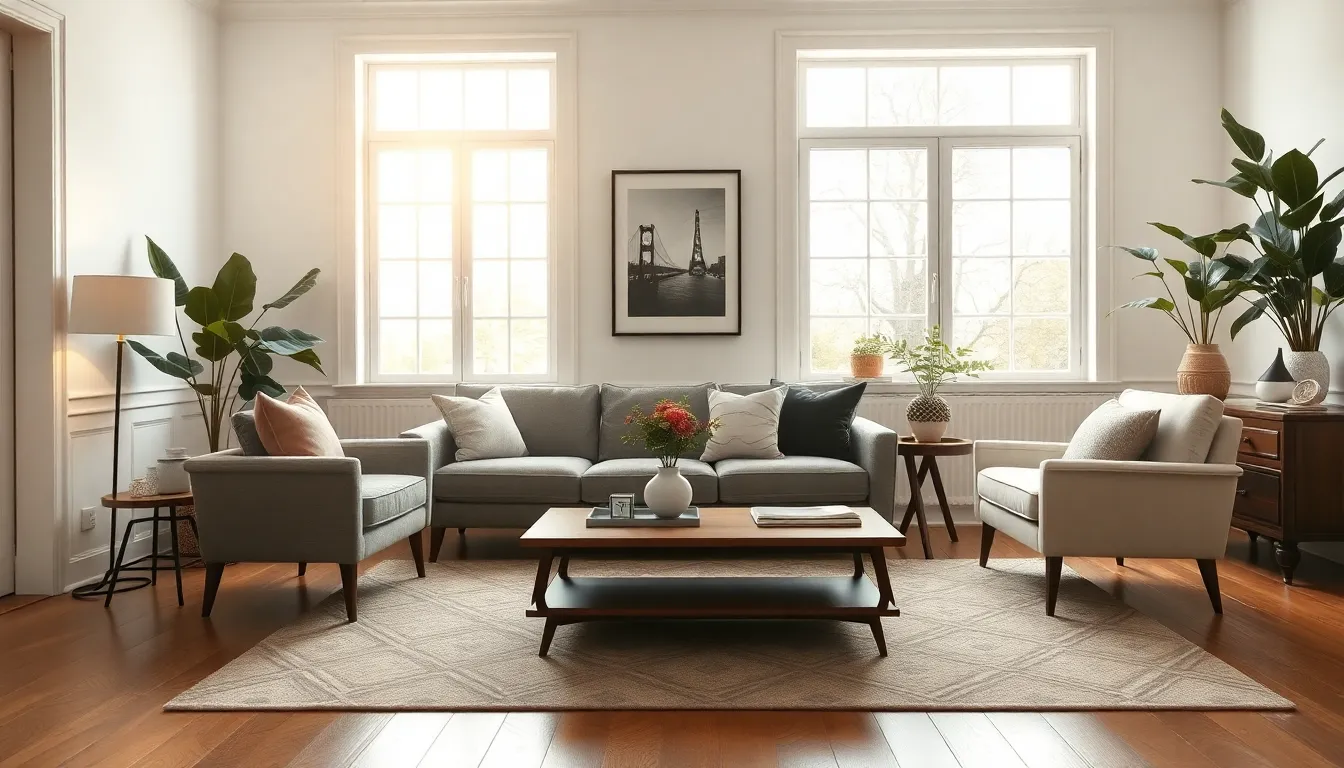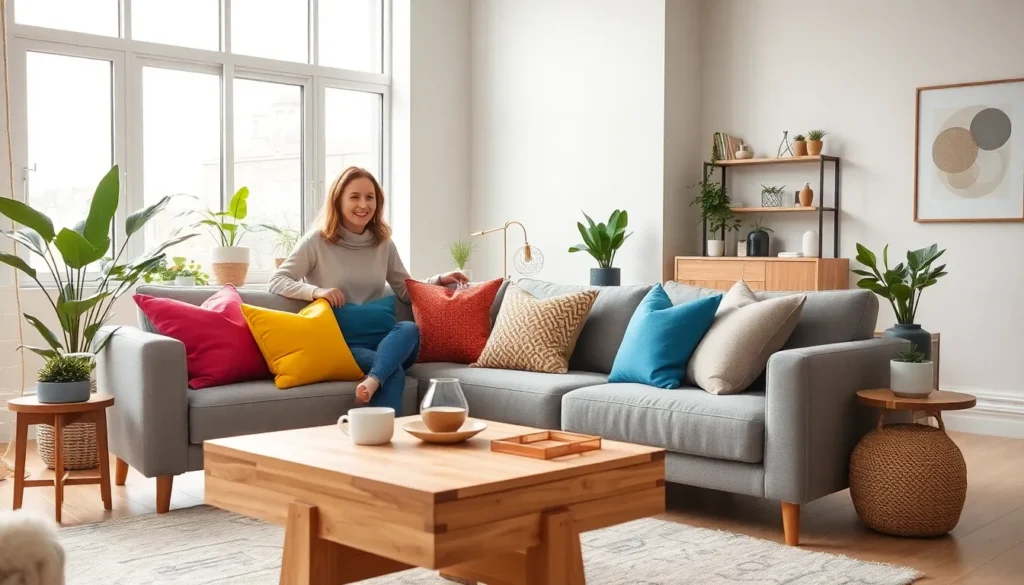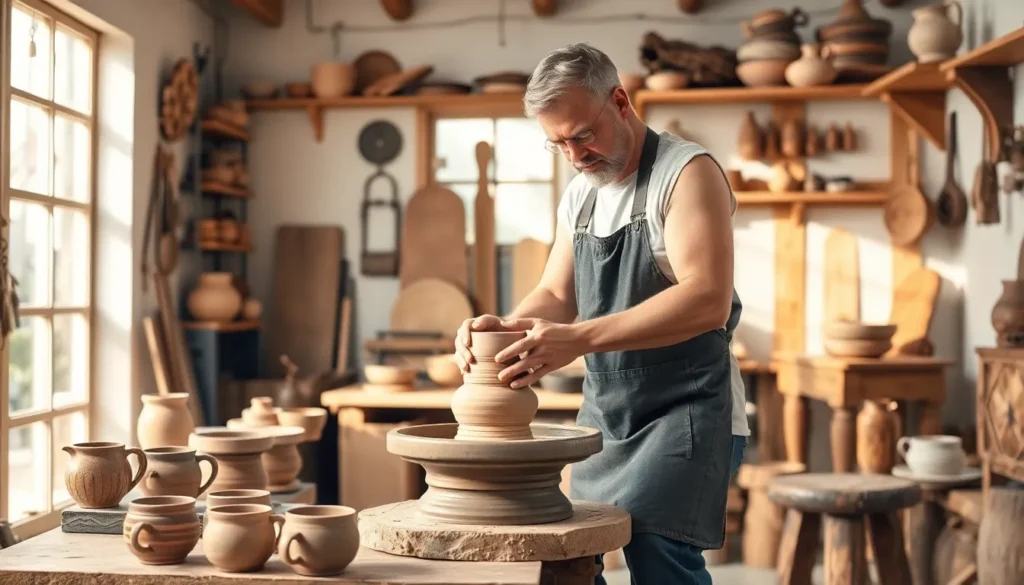Classic design concepts stand the test of time, proving that good taste never goes out of style. From the elegant lines of Art Deco to the simplicity of Mid-Century Modern, these principles not only shape our spaces but also influence our emotions. Imagine walking into a room that feels like a warm hug—thanks to well-thought-out design elements that resonate with both the eye and the soul.
Table of Contents
ToggleOverview of Classic Design Concepts
Classic design concepts encompass timeless styles that resonate across different eras. Each design concept brings unique attributes and emotional nuances, contributing to cohesive spaces.
Art Deco exemplifies luxury and glamour with bold colors and geometric shapes. Its visual elements evoke a sense of sophistication, largely seen in architecture and interior design. Influenced by the 1920s and 1930s, Art Deco’s vibrant aesthetics continue to inspire contemporary designs.
Mid-Century Modern focuses on simplicity and functionality, highlighting clean lines and organic forms. This design approach integrates natural materials, emphasizing a connection to nature. Designers like Charles and Ray Eames left a significant mark on this movement, crafting furniture that emphasizes both form and function.
Minimalism pursues a “less is more” philosophy, aiming for simplicity in aesthetics and functionality. This concept encourages open spaces and a limited color palette to produce a serene environment. Designers prioritize the essential elements, creating a feeling of tranquility.
Scandinavian design values minimalism and natural light, utilizing muted colors and well-crafted furnishings. The blend of form and function in this style promotes comfort and practicality. Simple yet elegant designs invite warmth into everyday living spaces.
Transitional design merges traditional and modern elements, appealing to a wide audience. This approach allows for a balanced environment that highlights comfort while maintaining style. Textures and colors play a significant role in creating a welcoming atmosphere.
Classic design concepts remain relevant, continuously enriching environments with their aesthetic and emotional appeal. Each concept contributes to creating spaces that respect the past while seamlessly integrating into modern life.
Key Characteristics of Classic Design Concepts

Classic design concepts possess distinctive features that contribute to their lasting appeal and effectiveness in creating inviting spaces.
Timelessness
Timelessness defines classic design concepts, making them enduring through trends. Styles like Art Deco and Mid-Century Modern remain influential due to their ability to evoke feelings of nostalgia while feeling contemporary. Standards of elegance associated with these designs resonate across generations. The adaptability of these styles allows them to integrate seamlessly into modern environments, ensuring relevance regardless of changing tastes.
Simplicity
Simplicity stands at the core of classic design. Designs often emphasize clean lines and minimal ornamentation, promoting an uncluttered aesthetic. Natural materials enhance this simplicity, inviting warmth and authenticity into spaces. Furthermore, the effectiveness of a “less is more” philosophy shines through with designs prioritizing function. Spaces created under this ethos foster calm and peace, allowing individuals to focus on comfort and practical living.
Balance and Harmony
Balance and harmony are essential elements in classic design concepts. Thoughtful arrangement of furniture and decor creates visual equilibrium within a space. Traditional and modern elements coexist effortlessly in Transitional designs, appealing to diverse tastes. Art Deco thrives on geometric shapes, achieving harmony through symmetry. Mid-Century Modern designs showcase an interplay of materials that enhances both cohesion and functionality, ensuring spaces feel complete yet inviting.
Famous Classic Design Concepts
Classic design concepts have shaped our understanding of aesthetics and functionality. Each style carries distinct features that resonate with different sensibilities and purposes.
The Golden Ratio
The Golden Ratio represents an enduring principle derived from mathematics, often found in nature and art. Designers employ this ratio to create visually pleasing compositions, achieving balance and harmony. Many architects incorporate it into building layouts to enhance visual appeal. Artists such as Leonardo da Vinci embraced this concept, allowing them to orchestrate proportions effectively. The ratio enhances beauty by guiding spacing and alignment, engaging viewers aesthetically and emotionally.
Minimalism
Minimalism champions simplicity and intentionality in design. This concept focuses on stripping away the non-essential, promoting the idea that less truly is more. Open spaces, clean lines, and functional furnishings characterize minimalist designs. Designers emphasize natural light, creating airy environments that feel spacious and intentional. By prioritizing functionality, minimalism evokes tranquility, inviting occupants to appreciate the beauty of unadorned spaces.
Art Deco
Art Deco evokes a sense of luxury and glamour that continues to captivate. Characterized by bold colors and geometric shapes, this style embodies sophistication and exuberance. Designers utilize materials like chrome and glass to enhance the aesthetic appeal of interiors and exteriors. Architecture often reflects symmetry, instilling a sense of order. Art Deco inspired design remains highly sought after for its timeless elegance and distinctive visual language, marrying opulence with functionality.
Influences on Modern Design
Classic design concepts profoundly shape modern design practices. Art Deco’s luxury and glamour influence contemporary aesthetics, characterized by bold colors and geometric shapes that create visual interest. Mid-Century Modern principles emphasized functionality, inspiring current layouts that favor clean lines and create seamless connections with nature.
Minimalism’s impact resonates in today’s design trends. Designers incorporate open spaces and purposeful furnishings that foster tranquility and simplicity. Scandinavian design elements also play a significant role, emphasizing natural light and muted color palettes that enhance comfort in living spaces.
Transitional design brings together traditional and modern aspects, appealing to diverse tastes. Many modern homes utilize this blend, balancing timeless sophistication with contemporary allure. Influences from these classic styles result not only in aesthetically pleasing environments but also in spaces that evoke comfort and emotional connection.
The Golden Ratio, a guiding principle in classic architecture and art, continues to be relevant. Designers rely on this mathematical ratio to achieve visual harmony in contemporary compositions. Iconic figures like Leonardo da Vinci exemplified its application, underscoring its significance across generations.
Art Deco’s allure remains undeniable in modern design. Its striking use of materials like chrome and glass captivates and inspires current trends, proving that classic concepts maintain their relevance. Each influential design concept contributes uniquely, enriching modern aesthetics while respecting historical roots.
Classic design concepts remain vital in shaping modern aesthetics. Their timeless attributes resonate with those seeking comfort and beauty in their environments. Each style offers unique elements that blend history with contemporary needs, ensuring they never go out of fashion.
The enduring influence of these designs fosters a deeper emotional connection to spaces. By embracing principles like balance, simplicity, and harmony, designers continue to create inviting atmospheres that reflect individual tastes. As classic concepts evolve, they inspire innovative approaches that honor the past while looking to the future. This ongoing dialogue between tradition and modernity highlights the significance of classic design in today’s world.









